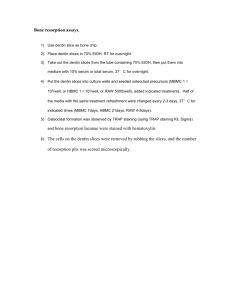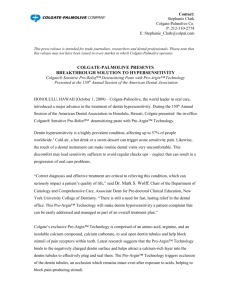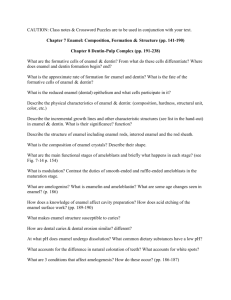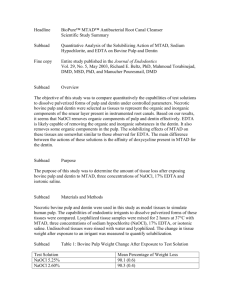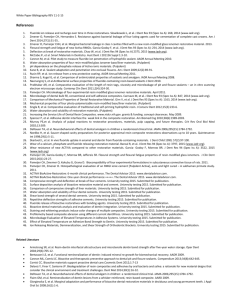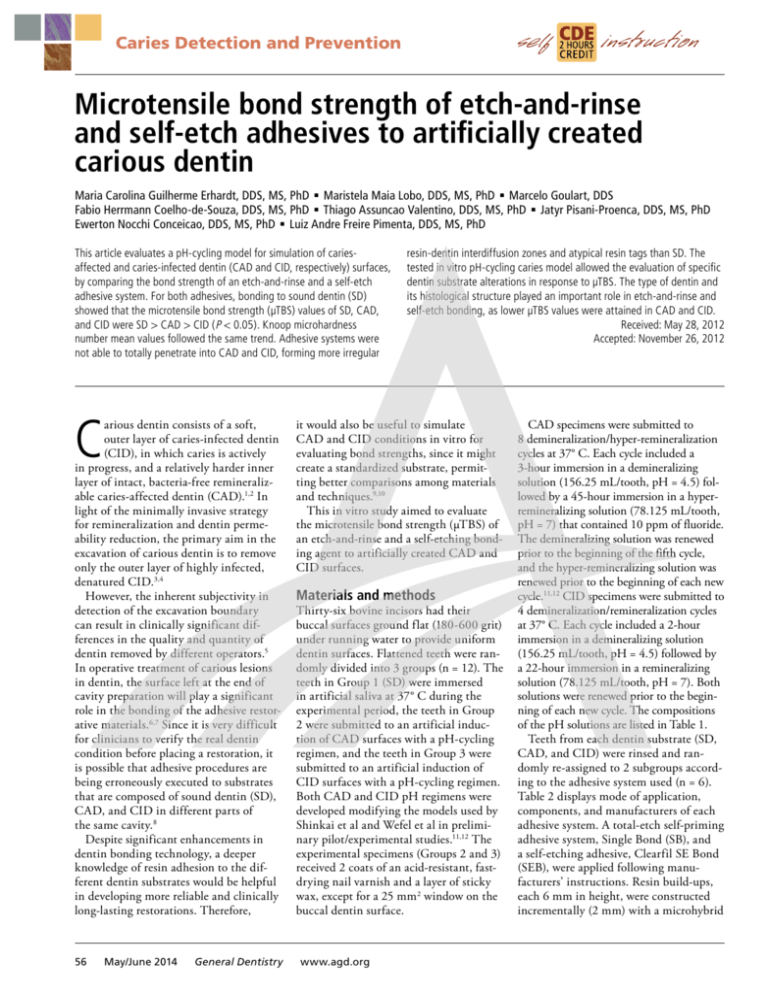
Caries Detection and Prevention
Microtensile bond strength of etch-and-rinse
and self-etch adhesives to artificially created
carious dentin
Maria Carolina Guilherme Erhardt, DDS, MS, PhD n Maristela Maia Lobo, DDS, MS, PhD n Marcelo Goulart, DDS Fabio Herrmann Coelho-de-Souza, DDS, MS, PhD n Thiago Assuncao Valentino, DDS, MS, PhD n Jatyr Pisani-Proenca, DDS, MS, PhD Ewerton Nocchi Conceicao, DDS, MS, PhD n Luiz Andre Freire Pimenta, DDS, MS, PhD
This article evaluates a pH-cycling model for simulation of cariesaffected and caries-infected dentin (CAD and CID, respectively) surfaces,
by comparing the bond strength of an etch-and-rinse and a self-etch
adhesive system. For both adhesives, bonding to sound dentin (SD)
showed that the microtensile bond strength (µTBS) values of SD, CAD,
and CID were SD > CAD > CID ( P < 0.05). Knoop microhardness
number mean values followed the same trend. Adhesive systems were
not able to totally penetrate into CAD and CID, forming more irregular
C
arious dentin consists of a soft,
outer layer of caries-infected dentin
(CID), in which caries is actively
in progress, and a relatively harder inner
layer of intact, bacteria-free remineralizable caries-affected dentin (CAD).1,2 In
light of the minimally invasive strategy
for remineralization and dentin permeability reduction, the primary aim in the
excavation of carious dentin is to remove
only the outer layer of highly infected,
denatured CID.3,4
However, the inherent subjectivity in
detection of the excavation boundary
can result in clinically significant differences in the quality and quantity of
dentin removed by different operators.5
In operative treatment of carious lesions
in dentin, the surface left at the end of
cavity preparation will play a significant
role in the bonding of the adhesive restorative materials.6,7 Since it is very difficult
for clinicians to verify the real dentin
condition before placing a restoration, it
is possible that adhesive procedures are
being erroneously executed to substrates
that are composed of sound dentin (SD),
CAD, and CID in different parts of
the same cavity.8
Despite significant enhancements in
dentin bonding technology, a deeper
knowledge of resin adhesion to the different dentin substrates would be helpful
in developing more reliable and clinically
long-lasting restorations. Therefore,
56
May/June 2014
General Dentistry
resin-dentin interdiffusion zones and atypical resin tags than SD. The
tested in vitro pH-cycling caries model allowed the evaluation of specific
dentin substrate alterations in response to µTBS. The type of dentin and
its histological structure played an important role in etch-and-rinse and
self-etch bonding, as lower µTBS values were attained in CAD and CID.
Received: May 28, 2012
Accepted: November 26, 2012
it would also be useful to simulate
CAD and CID conditions in vitro for
evaluating bond strengths, since it might
create a standardized substrate, permitting better comparisons among materials
and techniques.9,10
This in vitro study aimed to evaluate
the microtensile bond strength (µTBS) of
an etch-and-rinse and a self-etching bonding agent to artificially created CAD and
CID surfaces.
Materials and methods
Thirty-six bovine incisors had their
buccal surfaces ground flat (180-600 grit)
under running water to provide uniform
dentin surfaces. Flattened teeth were randomly divided into 3 groups (n = 12). The
teeth in Group 1 (SD) were immersed
in artificial saliva at 37° C during the
experimental period, the teeth in Group
2 were submitted to an artificial induction of CAD surfaces with a pH-cycling
regimen, and the teeth in Group 3 were
submitted to an artificial induction of
CID surfaces with a pH-cycling regimen.
Both CAD and CID pH regimens were
developed modifying the models used by
Shinkai et al and Wefel et al in preliminary pilot/experimental studies.11,12 The
experimental specimens (Groups 2 and 3)
received 2 coats of an acid-resistant, fastdrying nail varnish and a layer of sticky
wax, except for a 25 mm 2 window on the
buccal dentin surface.
www.agd.org
CAD specimens were submitted to
8 demineralization/hyper-remineralization
cycles at 37° C. Each cycle included a
3-hour immersion in a demineralizing
solution (156.25 mL/tooth, pH = 4.5) followed by a 45-hour immersion in a hyperremineralizing solution (78.125 mL/tooth,
pH = 7) that contained 10 ppm of fluoride.
The demineralizing solution was renewed
prior to the beginning of the fifth cycle,
and the hyper-remineralizing solution was
renewed prior to the beginning of each new
cycle.11,12 CID specimens were submitted to
4 demineralization/remineralization cycles
at 37° C. Each cycle included a 2-hour
immersion in a demineralizing solution
(156.25 mL/tooth, pH = 4.5) followed by
a 22-hour immersion in a remineralizing
solution (78.125 mL/tooth, pH = 7). Both
solutions were renewed prior to the beginning of each new cycle. The compositions
of the pH solutions are listed in Table 1.
Teeth from each dentin substrate (SD,
CAD, and CID) were rinsed and randomly re-assigned to 2 subgroups according to the adhesive system used (n = 6).
Table 2 displays mode of application,
components, and manufacturers of each
adhesive system. A total-etch self-priming
adhesive system, Single Bond (SB), and
a self-etching adhesive, Clearfil SE Bond
(SEB), were applied following manufacturers’ instructions. Resin build-ups,
each 6 mm in height, were constructed
incrementally (2 mm) with a microhybrid
Table 2. Bonding agents, compositions, and modes of application
used in the experimental groups.
Table 1. Compositions of the solutions
employed for the pH cycles.
Bonding agent
(manufacturer)
and batch no.
Solution (pH)
Composition
Demineralizing (4.5)
2.2 mM calcium chloride
phosphate (CaCl2 )
2.2 mM monosodium phosphate
(NaH2PO4 )
0.05 M sodium acetate
0.05 M acetic acid
1 ppm fluoride (NaF)
Remineralizing (7.0)
1.5 mM calcium chloride
phosphate (CaCl2 )
0.9 mM monosodium phosphate
(NaH2PO4 )
0.15 M potassium chloride (KCl)
0.1 M Tris buffer
Hyper-remineralizing (7.0) 1.5 mM calcium chloride
phosphate (CaCl2 )
0.9 mM monosodium phosphate
(NaH2PO4 )
0.15 M potassium chloride(KCl)
0.1 M Tris buffer
10 ppm fluoride (NaF)
resin composite, Filtek Z250 (3M ESPE).
Each layer of the composite was lightcured for 40 seconds with a halogen
light-curing unit (XL 2500, 3M ESPE).
Bonded specimens were stored in distilled
water for 24 hours at 37°C.
After storage, resin-dentin bonded
specimens were sectioned into slabs and
trimmed to an hourglass shape with
a fine diamond bur, giving a crosssectional area of 1 mm 2. Specimens
(4 slabs per tooth) were attached to a
prefabricated testing apparatus (Mortise
& Tenon MTJIG) with a cyanoacrylate
adhesive, and µTBS stressed (EMIC
Equipamentos e Sistemas de Ensaio
LTDA) at a crosshead speed of 0.5 mm/
min. The cross-sectional area at the site
of failure of the fractured specimens was
measured to the nearest 0.01 mm 2 with a
digital caliper (Mahr GmbH). Fractured
specimens were examined in a stereomicroscope (Meiji Techno America) at 40X
magnification to determine the mode of
failure. Failure modes were classified as
predominantly adhesive, mixed, or predominantly cohesive.
Single Bond
(3M ESPE)
1FH
Composition
Mode of application
HEMA, bysphenyl glycidyl
methacrylate, dimethacrylates,
amines, water, methacrylatefunctional, copolymer of
polyacrylic and polyitaconic
acids, ethanol.
Etch for 15 seconds. Rinse
with water spray for 10
seconds, leaving tooth moist.
Apply 2 consecutive coats
of the adhesive with a fully
saturated brush tip. Dry gently
for 5 seconds. Light-cure for
10 seconds.
Clearfil SE Bond
Primer: 10-MDP, HEMA,
(Kuraray America, Inc.) hydrophilic dimethacrylate,
352
di-camphorquinone, water,
N,N-diethanol-p-toludine.
Apply primer for 20 seconds.
Mild air stream. Apply bond.
Dry with gentle air stream.
Light-cure for 10 seconds.
Bond: 10-MDP, HEMA,
hydrophobic dimethacrylate,
N,N-diethanol-p-toluidine, dicamphorquinone, bis-phenol
A diglycidylmethacrylate,
silanated colloidal silica.
Abbreviations: HEMA, 2-hydroxyethyl methacrylate; 10-MDP, 10-methacryloyloxydecyl dihydrogen
phosphate.
The quality of the artificially induced
CAD and CID pH-cycling was confirmed
by the means of subsurface dentin Knoop
microhardness number (KHN) evaluations.13 Following bond strength testing
and fracture mode evaluation, the lateral
aspects—which were the nonbonded
surfaces—of the resin-dentin interface
of 2 debonded specimens per tooth were
polished with 1000 grit SiC abrasive
papers and diamond pastes of 6, 3,
and 1 µm (Arotec SA). Specimens were
sonicated for 10 minutes to remove the
debris in an Ultrasonic Cleaner (T.1440D,
Odontobras). KHN indentations were
performed 50 µm below the adhesive/
dentin interface using a hardness tester
(FM-1e, Future-Tech), under a load of 5 g
for 15 seconds.14 Each specimen received
3 indentations at 150 µm intervals. The
average of the 3 indentations was used as
the value for each specimen.
Additional specimens for each group
were submitted to the pH-cycling
regimen (as previously described) and
prepared to be evaluated by scanning
electron microscopy (SEM). Bonded
www.agd.org
resin-dentin interfaces were perpendicularly sectioned, gently decalcified (37%
phosphoric acid for 10 seconds) and
subsequently deproteinized (2% NaOCl
solution for 1 minute). Samples were
maintained in a desiccator for 48 hours,
mounted in aluminum stubs, sputtercoated with gold, and observed under
SEM (JSM 5600LV, JEOL Ltd.).
The µTBS data obtained were subjected
to 2-way ANOVA (P = 0.05) and Tukey’s
post hoc test at a significance level of 5%.
In a secondary, supportive analysis, KHN
data of each adhesive system were separately subjected to Student’s t-test in order
to compare SD and CAD KHN values.
The analyses were performed with SAS
System 6.11 software (SAS Institute, Inc.).
Results
The µTBS values are summarized in
Table 3. The adhesive system used was not
a significant factor (P = 0.227), while the
dentin type had a significant influence on
bond strength (P < 0.001). The interaction
between the independent variables was not
significant (P = 0.125).
General Dentistry
May/June 2014
57
Caries Detection and Prevention Microtensile bond strength of adhesives to artificially created carious dentin
Table 3. Mean µTBS values (standard deviations) of tested adhesives bonded to sound dentin (SD), artificially-created cariesaffected dentin (CAD), and caries-infected dentin (CID). Failure mode distribution is listed as percentages. For each adhesive/
dentin combination, n = 35.
SD
Dentin adhesive
CAD
CID
MPa
A
M
C
KHN
MPa
A
M
C
KHN
MPa
A
M
C
KHN
Single Bond
31.0 (4.3) a
33
67
0
65.4 (5.1)1
24.0 (5.9) b
42
53
5
37.3 (8.4)2
13.6 (5.4) c
57
37
6
12.8 (3.6)3
Clearfil SE Bond
28.0 (6.0) a
40
59
1
63.8 (5.6)1
19.3 (6.7) b
45
50
5
28.9 (6.6)2
15.8 (4.6) c
51
42
7
11.6 (3.8)3
Abbreviations: A, predominantly adhesive; M, mixed; C, cohesive in dentin; KHN, Knoop hardness number. Standard deviations (SD) were measured for MPa and KHN values.
Statistically significant differences are expressed by different lowercase letters ( P < 0.05). Different numbers indicate statistically significant differences for KHN values between
dentin substrates ( P < 0.05).
R
R
HL
HL
T
T
10 µm
10 µm
Fig. 1. Scanning electron microscopy (SEM) images of resin in sound dentin polished cross sections Left. Bonded with Single Bond etchand-rinse (SB) system. Right. Bonded with Clearfil SE Bond self-etch (SEB) system. The SB system tends to model a thicker hybrid layer
than the SEB system. For both adhesives, a regular formation of hybrid layer and resin tags is observed. (2000X). Abbreviations: R, resin
composite; T, resin tags; HL, hybrid layer.
Post hoc comparisons revealed that
the bonding of both adhesives to CAD
generated significantly lower mean µTBS
values than those obtained with SD. CID
presented the lowest µTBS values. No
significant differences between the SB
and the SEB systems were detected in the
dentin substrates.
An evaluation of KHN followed the
same trend as the µTBS results: SD produced significantly higher KHN values
than CAD which, in turn, were significantly higher than those obtained in CID.
The percentage of adhesive failures was
higher when bond strength decreased.
Dentin cohesive failures were frequently
observed in CAD and CID interfaces.
SEM examinations of the resin-dentin
interfaces are shown in Figures 1-3.
When bonded to SD, the SB and SEB
58
May/June 2014
General Dentistry
systems were able to penetrate into dentin
forming an extensive resin-dentin interdiffusion zone. When the SB was used,
4-5 µm-thick hybrid layers were created,
while approximately 1 µm-thick hybrid
layers were produced by the SEB system.
Relatively thick and irregular hybrid
layers were produced in CAD and CID
for both adhesive systems. Mineral casts
in CAD were only partially removed
from the tubules, allowing the creation
of spongy resin tags. In CID, the intertubular dentin matrix appeared to be
overetched by the conditioning agents, as
poor adhesive resin penetration into the
demineralized dentin zone was observed.
Compared to SD or CAD, the hybrid
layer was more porous, with collapsed
resin tags comprising residual dentin
chips and denatured collagen.
www.agd.org
Discussion
Laboratory investigations that evaluate
dentin bond strength are normally conducted on noncarious dentin substrates,
which do not necessarily represent the most
common dentin type encountered during
restorative procedures in clinics. Therefore,
this study aimed to evaluate the µTBS of
etch-and-rinse and self-etching adhesive
systems to artificially created CAD and
CID surfaces. Bonding to SD with tested
adhesive systems in this study produced
significantly higher µTBS values than those
with artificially created CAD and CID.
The type of dentin retained following
caries excavation can affect the results of
bond strength tests.5,15 Thus, there are
several problems that may affect bonding
efficacy when etch-and-rinse and self-etch
adhesive systems are used on CAD and
R
R
HL
HL
T
T
10 µm
10 µm
Fig. 2. SEM images of bonded resin-dentin interfaces in artificially induced caries-affected dentin. Left. Bonded with SB system.
Right. Bonded with SEB system. Bonded interfaces presented irregularly shaped resin tags and thicker hybrid layers than those observed
for normal dentin (2000X). Abbreviations: R, resin composite; T, resin tags; HL, hybrid layer.
R
HL
HL
T
T
10 µm
10 µm
Fig. 3. SEM images of artificially induced caries-infected dentin bonded interfaces. Left. Bonded with SB system. Right. Bonded with SEB
system. Dentin matrix was completely dissolved from tubules close to the surface, with the resultant spaces poorly filled with the adhesive
resins. (2000X). Abbreviations: R, resin composite; T, resin tags; HL, hybrid layer.
CID.8,16,17 There were no significant differences in this study between the SB and
SEB systems in µTBS values to the respective dentin substrates. The lower bond
strengths attained when bonding to CAD
compared to SD were probably related to
the lack of resin tag formation due to the
presence of acid-resistant whitlockite mineral casts within the tubules, and decreases
in the modulus of elasticity and in dentin
cohesive strength.8,17-19 Regarding CID,
a complete loss of its mineral phase and
denaturation of the collagen matrix may
have led to a decrease in the chemical
bonding between carboxylic or phosphate
derivatives of the resin monomers.16-18
As a consequence, µTBS values attained
in CAD and CID in this study were not
unexpected, and corroborate previously
published investigations that used natural
carious dentin lesions.13,14,17 Therefore, the
proposed pH cycling method applied in
this study was effective in producing different dentin substrates.
Since the accomplishment of CAD
and CID surfaces has been performed
in vitro by means of a pH-cycling regimen, great care was taken to characterize
the bonded substrate.11,20,21 Bovine teeth
were used instead of human teeth, as it is
easier to control these teeth in terms of
age, sclerosis, and the amount of wear of
the substrate.21-23 According to Schilke et
al, bovine coronal dentin is considered
a suitable substitute for human molar
dentin in adhesion studies.24 The mineral
phase of experimental dentin samples
was remodeled by dynamic sequences of
www.agd.org
demineralization/hyper-remineralization
for CAD or by sequences of demineralization/remineralization for CID, aiming to
simulate the 2 layers of carious dentin in
vivo.13,25 In fact, artificially created CAD
specimens had lost half of their hardness,
but their tubules were so full of mineral
material that resin tag formation was
hindered when compared to SD. The same
trend was observed for CID. It is likely
that the loosely arranged mineral casts in
the dentin surface permitted a deeper etching of intertubular dentin.16 The presence
of a denatured collagen matrix may have
prevented proper resin infiltration during
bonding, lowering final bond strengths.8,17
These changes in the permeability
and acid-resistance of artificially created dentin samples after the different
General Dentistry
May/June 2014
59
Caries Detection and Prevention Microtensile bond strength of adhesives to artificially created carious dentin
pH-cycling regimens were morphologically evident in the SEM images. Analysis
of CAD interfaces showed that both
adhesive systems were not able to perfectly
permeate dentin, forming thicker and
more irregular hybrid layers than SD. An
easier diffusion of acidic conditioners in
CAD was a result of an increased porosity
in the intertubular dentin. This increased
porosity did not imply a correct infiltration of the adhesive monomers: resin
penetration was hampered by the presence
of acid-resistant mineral casts in the dentinal tubules.13,14,17,19 A more pronounced
variation was found in CID interfaces.
Adhesive resins penetrated through the
loose, degraded dentin matrix to a higher
depth than CAD, forming resin tags that
were fused together with residual mineral
deposits and denatured collagen. Tubule
fusion due to loss of peritubular dentin
and enlargement of lateral branches has
been previously described.8,26
Significant differences were observed
between all dentin types in terms of
microhardness evaluations. The lowest
KHN values were obtained for artificially
induced CAD and CID, which are similar
to those reported by other authors.14,27,28
The lower KHN values in CID and CAD
are related to a smaller number of larger
apatite crystals that no longer fit properly
into inter- and intrafibrillar spaces in a
normal collagen matrix, as well as to a
lower cohesive strength of the disorganized collagen matrix.8,10,18 Therefore, the
attained differences in microtensile and
microhardness evaluations for these dentin
conditions showed the consistency of the
proposed dynamic pH-cycling as a method
to artificially obtain CAD and CID.
The findings of this study cannot be
compared with previous in vitro studies
that performed bonding to artificial CAD
and CID lesions.9,11,20,28,29 The relative
effectiveness of the hyper-remineralizing
solution (used for CAD simulation in the
present study) is partially a result of its
fluoride content. Fluoride at 10 ppm may
have produced a consistent growth of very
small apatite crystallites in the gap region
of collagen fibrils to form intra- and
interfibrillar mineralization.20,30,31 These
precipitations arose from the reaction of
fluoride, calcium, and phosphate ions
contained in the demineralized dentin
layer.31 To obtain artificial CAD, surfaces
60
May/June 2014
General Dentistry
were demineralized 8 times for 3 hours
but remineralized for 8 cycles of 45 hours
each. This means that a much longer
remineralizing time was used. The main
difference of the proposed pH-cycling
method is that in this study, a dynamic
process of de-hyperemineralization for
CAD or de-remineralization for CID
was performed repeatedly, in order to
reproduce more closely the real situation
that takes place in the oral environment.
This technique provided a much better
simulation of carious dentin than that of
previously published literature.
Many factors present in natural
CAD and CID lesions may play an
important role in the final bonding
performance of resin-based materials.
During the caries process, the organic
matrix is exposed to breakdown by bacterial- and host-derived enzymes, such as
the matrix metalloproteinases present
within the dentin and derived from
saliva.32,33 Moreover, the Maillard reaction
between sugar and proteins that occurs
during the caries process induces the
addition of metabolites and glycoxidation
products to the carious dentin matrix
collagen, modifying the dentin organic
matrix.34 Clinically, natural CID contains
a necrotic collagen matrix and collapsed
dentin tubules that are highly infected by
bacteria that induce cytokine reactions,
which may elicit a chronic pulpal inflammation.27 Although the use of natural
CAD and CID is desirable, the in vitro
method attained results with the proposed
pH-cycling model, providing data that
suggests that manipulation of parameters
involved in de- and re-mineralization
events has a significant effect on the
behavior of the dentin surface, particularly in the bonding phenomenon.
Conclusion
Based on the low bond strengths observed
in CAD and CID, it could be suggested
that there is a need for development of
further bonding alternatives in order to
improve the adhesion of resin composites
to these different substrates. However, it
must be emphasized that if the cavity to
be restored presents enamel or even SD
margins, such a problem might not be so
severe.35,36 The clinical decision of leaving remaining CID underneath bonded
restorations is still a subject of substantial
www.agd.org
debate and deserves further investigation.
The findings of the present study highlight
the possibility of this pH-cycling method
to be used as a standardized in vitro model
for the simulation of pathologically altered
dentin surfaces for bonding evaluations.
Bond strengths of etch-and-rinse and
self-etch adhesive systems to artificiallyinduced CAD and CID were significantly lower than those attained in SD.
Regardless of the substrate, both adhesive
systems presented similar bond strengths.
Author information
Drs. Erhardt, Coelho-de-Souza, and
Conceicao are adjunct professors,
Department of Conservative Dentistry,
School of Dentistry, Federal University
of Rio Grande do Sul, Brazil, where
Dr. Goulart is a research fellow and doctoral student. Dr. Lobo is a clinical professor, School of Dentistry, Senac University,
Sao Paulo, Brazil. Dr. Valentino is an
assistant professor, School of Dentistry,
University of Uberaba, Brazil. Dr. PisaniProenca is in private practice in Porto
Alegre, Brazil. Dr. Pimenta is a clinical
professor, Department of Dental Ecology,
School of Dentistry, University of North
Carolina at Chapel Hill.
References
1. Kuboki Y, Ohgushi K, Fusayama T. Collagen biochemistry of the two layers of carious dentin. J Dent Res.
1977;56(10):1233-1237.
2. Liu Y, Li N, Qi Y, et al. The use of sodium trimetaphosphate as a biomimetic analog of matrix phosphoproteins for remineralization of artificial caries-like dentin.
Dent Mater. 2011;27(5):465-477.
3. Kawasaki K, Ruben J, Stokroos I, Takagi O, Arends J.
The remineralization of EDTA-treated human dentine.
Caries Res. 1999;33(4):275-280.
4. Massler M. Changing concepts in the treatment of
carious lesions. Br Dent J. 1967;123(11):547-548.
5. Banerjee A, Kidd EA, Watson TF. In vitro evaluation of
five alternative methods of carious dentine excavation.
Caries Res. 2000;34(2):144-150.
6. Eick JD, Gwinnett AJ, Pashley DH, Robinson SJ. Current concepts on adhesion to dentin. Crit Rev Oral
Biol Med. 1997;8(3):306-335.
7. Nakabayashi N. The hybrid layer: a resin-dentin composite. Proc Finn Dent Soc. 1992;88(Suppl 1):321329.
8. Yoshiyama M, Tay FR, Torii Y, et al. Resin adhesion to
carious dentin. Am J Dent. 2003;16(1):47-52.
9. Cilli R, Prakki A, de Araujo PA. Evaluating a method of
artificially hypermineralizing dentin to simulate natural
conditions in bonding studies. J Adhes Dent. 2005;
7(4):271-279.
10. Erhardt MC, Rodrigues JA, Valentino TA, Ritter AV, Pimenta LA. In vitro microTBS of one-bottle adhesive
systems: sound versus artificially-created
Published with permission by the Academy of General Dentistry. © Copyright 2014
by the Academy of General Dentistry. All rights reserved. For printed and electronic
reprints of this article for distribution, please contact rhondab@fosterprinting.com.
caries-affected dentin. J Biomed Mater Res B Appl Biomater. 2008; 86(1):181-187.
11. Shinkai RS, Cury AA, Cury JA. In vitro evaluation of
secondary caries development in enamel and root
dentin around luted metallic restoration. Oper Dent.
2001;26(1):52-59.
12. Wefel JS, Heilman JR, Jordan TH. Comparisons of in
vitro root caries models. Caries Res. 1995;29(3):204209.
13. Ogawa K, Yamashita Y, Ichijo T, Fusayama T. The ultrastructure and hardness of the transparent layer of human carious dentin. J Dent Res. 1983;62(2):7-10.
14. Ceballos L, Camejo DG, Victoria Fuentes M, et al. Microtensile bond strength of total-etch and self-etching
adhesives to caries-affected dentine. J Dent. 2003;
31(7):469-477.
15. Banerjee A, Kellow S, Mannocci F, Cook RJ, Watson TF.
An in vitro evaluation of microtensile bond strengths
of two adhesive bonding agents to residual dentine
after caries removal using three excavation techniques.
J Dent. 2010;38(6):480-489.
16. Lee KW, Son HH, Yoshiyama M, Tay FR, Carvalho RM,
Pashley DH. Sealing properties of a self-etching primer
system to normal caries-affected and caries-infected
dentin. Am J Dent. 2003;16 Spec No:68A-72A.
17. Yoshiyama M, Tay FR, Doi J, et al. Bonding of self-etch
and total-etch adhesives to carious dentin. J Dent Res.
2002;81(8):556-560.
18. Marshall GW, Habelitz S, Gallagher R, Balooch M,
Balooch G, Marshall SJ. Nanomechanical properties of
hydrated carious human dentin. J Dent Res. 2001;
80(8):1768-1771.
19. Marshall GW Jr, Chang YJ, Gansky SA, Marshall SJ.
Demineralization of caries-affected transparent dentin by citric acid: an atomic force microscopy study.
Dent Mater. 2001;17(1):45-52.
20. Featherstone JD. Modelling the caries-inhibitory effects
of dental materials. Dent Mater. 1996;12(3):194-197.
21. Hara AT, Queiroz CS, Giannini M, Cury JA, Serra MC.
Influence of the mineral content and morphological
pattern of artificial root caries lesion on composite resin bond strength. Eur J Oral Sci. 2004;112(1):67-72.
22. Nakamichi I, Iwaku M, Fusayama T. Bovine teeth as
possible substitutes in the adhesion test. J Dent Res.
1983;62(10):1076-1081.
23. ten Cate JM, van Duinen RN. Hypermineralization of
dentinal lesions adjacent to glass-ionomer cement restorations. J Dent Res. 1995;74(6):1266-1271.
24. Schilke R, Bauss O, Lisson JA, Schuckar M, Geurtsen W.
Bovine dentin as a substitute for human dentin in
shear bond strength measurements. Am J Dent. 1999;
12(2):92-96.
25. Fusayama T, Terashima S. Differentiation of two layers
of carious dentin by staining. Bull Tokyo Med Dent
Univ. 1972;19(1):83-92.
26. Frank RM, Steuer P, Hemmerle J. Ultrastructural study
on human root caries. Caries Res. 1989;23(4):209217.
27. Hahn CL, Best AM, Tew JG. Cytokine induction by
Streptococcus mutans and pulpal pathogenesis. Infect
Immun. 2000;68(12):6785-6789.
28. Ehudin DZ, Thompson VP. Tensile bond strength of
dental adhesives bonded to simulated caries-exposed
dentin. J Prosthet Dent. 1994;71(2):165-173.
29. Sattabanasnk V, Shimada Y, Tagami J. Bonding of resin
to artificially carious dentin. J Adhes Dent. 2005;7(3):
183-192.
30. Arends J, Christoffersen J, Ruben J, Jongebloed WL.
Remineralization of bovine dentine in vitro. The influence of the F content in solution on mineral distribution. Caries Res. 1989;23(5):309-314.
31. Iijima Y, Ruben JL, Zuidgeest TG, Arends J. Fluoride and
mineral content in hyper-remineralized coronal bovine
dentine in vitro after an acid challenge. Caries Res.
1993;27(2):106-110.
32.van Strijp AJ, van Steenbergen TJ, de Graaff J, ten
Cate JM. Bacterial colonization and degradation of demineralized dentin matrix in situ. Caries Res. 1994;
28(1):21-27.
33. Tjaderhane L, Larjava H, Sorsa T, Uitto VJ, Larmas M,
Salo T. The activation and function of host matrix
www.agd.org
metalloproteinases in dentin matrix breakdown in caries lesions. J Dent Res. 1998;77(8):1622-1629.
34. Kleter GA, Damen JJ, Buijs MJ, Ten Cate JM. Modification of amino acid residues in carious dentin matrix.
J Dent Res. 1998;77(3):488-495.
35. Mertz-Fairhurst EJ, Curtis JW Jr, Ergle JW, Rueggeberg
FA, Adair SM. Ultraconservative and cariostatic sealed
restorations: results at year 10. J Am Dent Assoc.
1998;129(1):55-66.
36. Ribeiro CC, Baratieri LN, Perdigao J, Baratieri NM, Ritter AV. A clinical, radiographic, and scanning electron
microscopic evaluation of adhesive restorations on
carious dentin in primary teeth. Quintessence Int.
1999;30(9):591-599.
Manufacturers
Arotec SA, Sao Paulo, Brazil
55.11.4613.860, arotec.com.br
EMIC Equipamentos e Sistemas de Ensaio LTDA,
San Jose dos Pinhais, Brazil
55.42.3035.9400, www.emic.com.br
Future-Tech, Kanagawa Prefecture, Japan
81.44.270.5789, www.ft-hardness,com
JEOL Ltd., Welwyn Garden City, England
44.170.7377.117, www.jeol.com
Kuraray America. Inc., New York, NY
800.879.1676, www.kuraraydental.com
Mahr GmbH, Gottingen, Germany
49.551.7073.800, www.mahr.com
Meiji Techno America, San Jose, CA
800.832.0080, www.meijitechno.com
Odontobras, Curitiba, Brazil
55.16.4141.2969, www.odontobras.com
SAS Institute, Inc., Cary, NC
800.727.0025, www.sas.com
3M ESPE, St. Paul, MN
888.364.3577, solutions.3m.com
General Dentistry
May/June 2014
61

